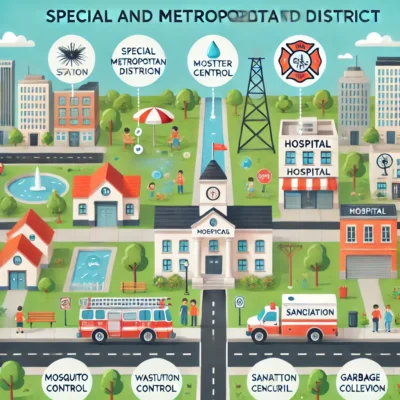Understanding Special and Metropolitan Districts in Colorado: What Homeowners and Buyers Should Know
When buying or owning property in Colorado, it’s important to understand how certain public services are delivered—and how they’re funded. One key piece of this puzzle is understanding Special Districts and Metropolitan Districts in Colorado. These districts play a critical role in community development and infrastructure, yet many homeowners are unfamiliar with how they work.
🏡 What Are Special Districts?
To begin with, a Special District is a local unit of government created to provide specific services that cities or counties may not offer directly. These services can include:
- Fire protection
- Hospital services
- Parks and recreation
- Water supply and distribution
- Sanitation and waste management
Typically, each district focuses on just one type of service. These districts are funded through property taxes, service fees, or a combination of both. As a result, these costs often appear on your annual property tax bill.
🌐 What Are Metropolitan Districts?
In contrast, a Metropolitan District—or Metro District—is a broader type of special district. Rather than offering just one service, Metro Districts are designed to provide two or more essential services, such as:
- Water and sanitation
- Parks and recreation
- Fire protection
- Safety and security
- Transportation and road maintenance
- Garbage collection
- Mosquito control
Often, developers establish these districts in newly built neighborhoods to finance infrastructure like roads, sidewalks, sewer lines, and public spaces. Over time, homeowners contribute to paying off these infrastructure costs through property taxes or special assessments.
💡 Why Does This Matter to Homeowners and Buyers?

Now, you may be wondering—why is this important for you as a homeowner or buyer? Here are a few key reasons:
- Higher Property Taxes: Metro District taxes can sometimes be significant. Therefore, it’s wise to review your tax bill carefully and ask your real estate agent or title company for details.
- Access to Community Services: These districts often fund the amenities and services that make neighborhoods functional, safe, and enjoyable.
- Impact on Resale Value: A well-managed district can enhance property values, whereas poorly managed ones can raise concerns for potential buyers.
- Homeowner Involvement: Additionally, since district boards are public entities, residents can attend meetings, review budgets, and even run for board positions.
📝 Final Thoughts
In summary, Special and Metro Districts help fill essential service gaps in growing communities. While they may seem complex at first, understanding how they work can help you make informed decisions about where to buy and how your tax dollars are used.
So, the next time you’re reviewing a property tax bill or shopping for a new home, take a moment to check which districts serve the area. It’s a small step that can make a big difference in your homeownership experience.
Have questions about the districts in your neighborhood? I’d be happy to help you navigate the details—just reach out anytime!

